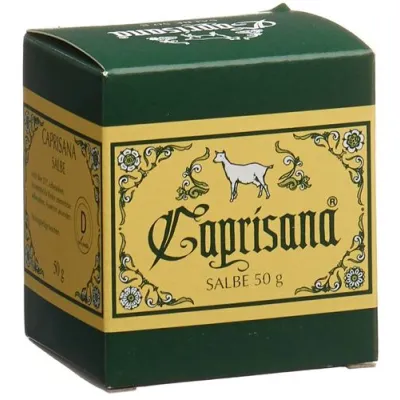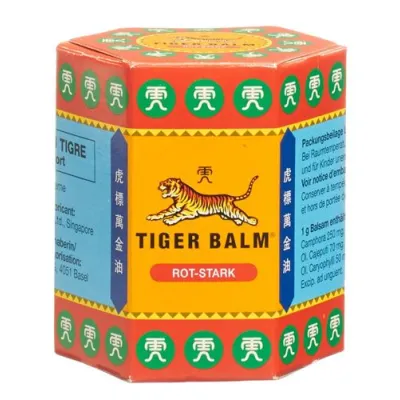best ointment for muscle and joint pain
(1 Pages)
Caprisana ointment pot 50 g
What is Caprisana and when is it used? Experience has shown that Caprisana is used for the symptomatic treatment of rheumatic complaints such as arthritis, arthrosis and joint and muscle pain. When should Caprisana not be used? Caprisana should not be used on skin diseases and skin injuries. You should also refrain from using Caprisana if you have a known allergy to essential oils in general or turpentine oil in particular, or if you are known to be hypersensitive to the additives used. Caprisana must not be applied to open areas of skin. Caprisana must not be used in children under the age of 12. When is caution required when using Caprisana? In patients with previously damaged kidneys, Caprisana ointment may only be used for a short time and not over large areas. Avoid contact with eyes and mucous membranes. Caprisana must not be used if there is a known hypersensitivity to one of the ingredients, nor in children, not on damaged skin (wounds, eczema), not on mucous membranes (eyes, nose)! Caution is also required if you tend to have allergies.ExcipientsButylated hydroxyanisole (E 320) can cause localized skin irritation (e.g. contact dermatitis), irritation of the eyes and mucous membranes. Methyl- and propyl-4-hydroxybenzoates (E 218, E 216) can cause allergic reactions, including delayed reactions.Inform your doctor, pharmacist or druggist if yousuffer from other diseases,have allergies ortake other medicines (including those you bought yourself!) or Use externally.May Caprisana be taken/used during pregnancy or breastfeeding?No systematic scientific studies have been carried out. Caprisana should therefore not be used during pregnancy and breastfeeding unless it is clearly necessary and only with a doctor's prescription.How do you use Caprisana?Adults and adolescents from the age of 12:Unless otherwise prescribed by the doctor, rub a hazelnut-sized piece of ointment into the painful area 2-4 times a day. For external use only. An uninterrupted use of more than 2 months should be avoided. The use and safety of Caprisana has not yet been tested in children under the age of 12. In the event of an overdose - e.g. if children accidentally swallow large quantities - undesirable effects or poisoning cannot be ruled out. In such a case, ask a specialist or contact Tox Info Suisse. Stick to the dosage specified in the package insert or prescribed by the doctor. If you think the medicine is too weak or too strong, talk to your doctor, pharmacist or druggist.What side effects can Caprisana have?The following side effects can occur when using Caprisana:Rarely (affects 1 to 10 in 10,000 people)Especially with Sensitive skin or long-term use can lead to sensitization, which makes it necessary to discontinue the drug. However, a slight and soon temporary reddening of the skin is normal due to the circulation-enhancing properties. If you experience unusual discomfort when using Caprisana (e.g. severe and persistent reddening of the skin, blistering, itching or burning skin), the treatment must be stopped and it is recommended that you consult your doctor or nurse. the doctortin.Uncommon (affects 1 to 10 in 1000 people treated)Long-term use over large areas can cause nausea, vomiting or abdominal pain due to the camphor it contains.Rare (affects 1 to 10 in 10,000 people treated)In rare cases, serious side effects such as seizures, headaches, dizziness, confusion, restlessness, anxiety, hallucinations or severe shortness of breath. In these cases, a doctor should be consulted immediately. In the event of an overdose - e.g. if children accidentally swallow large amounts - undesirable effects or poisoning cannot be ruled out. In such a case, ask a specialist or contact Tox Info Suisse. If you notice any side effects, contact your doctor, pharmacist or druggist. This also applies in particular to side effects that are not listed in this leaflet.What else needs to be taken into account?The medicinal product may only be used up to the date marked «EXP» on the container.Storage instructionsStore at room temperature (15-25°C) and out of the reach of children.Further informationDo not take.Your further information can be obtained Doctor, pharmacist or druggist or your doctor, pharmacist or druggist. These people have the detailed technical information.What does Caprisana contain?1 g Caprisana contains:Active ingredients20 mg D-camphor, 20 mg juniper oil, 20 mg rosemary oil, 20 mg medicinal turpentine oil, 20 mg thyme oil, 12 mg larch turpentine, 470 mg goat butterExcipients Sunflower oil, methyl 4-hydroxybenzoate (E 218), propyl 4-hydroxybenzoate (E 216), butylated hydroxyanisole (E 320), copper complexes of chlorophylls and chlorophyllins (E141), yellow wax, hard paraffin, virgin olive oil, sodium hydrogen carbonate Authorization number 39716 (Swissmedic) Where can you get Caprisana? Which packs are available? In pharmacies and drugstores, without a doctor's prescription. Pots of 50 g and 95 g ointment Authorization holder Tentan AG, 4452 Itingen This leaflet was last checked by the drug authority (Swissmedic) in February 2022. PI 0 92100/03.22..
68.44 USD
Tiger balm ointment red strong pot 19.4 g
Tiger Balm, Ointment and Tiger Balm Oil are preparations for external use. Tiger Balm, ointment contains camphor, menthol and essential oils as active ingredients. Tiger Balm Oil also contains methyl salicylate. They are used to help treat: Rheumatism, muscle, joint and limb pain, lumbago, back pain, sports injuries such as sprains, sore muscles, strains and contusions. Tiger Balm products can also be used to treat common colds such as upper respiratory tract infections. Tiger Balm white, ointment Tiger Balm white, ointment can be used externally for mild headaches. Swissmedic-approved patient informationTiger Balm red/Tiger Balm white/Tiger Balm oil Doetsch Grether AG What is Tiger Balm/Tiger Balm oil and when is it used?Tiger Balm, Ointment and Tiger Balm Oil are preparations for external use. Tiger Balm, ointment contains camphor, menthol and essential oils as active ingredients. Tiger Balm Oil also contains methyl salicylate. They are used to help treat: Rheumatism, muscle, joint and limb pain, lumbago, back pain, sports injuries such as sprains, sore muscles, strains and contusions. Tiger Balm products can also be used to treat common colds such as upper respiratory tract infections. Tiger Balm white, ointmentTiger Balm white, ointment can be used externally for mild headaches. When should Tiger Balm/Tiger Balm Oil not be used?In the event of hypersensitivity to any of the active ingredients or excipients (see What is in Tiger Balm/Tiger Balm Contain oil?).If you are allergic to essential oils.Do not use on open wounds and eczematous skin.Tiger Balm Oil may be used if you are hypersensitive to other pain and anti-inflammatory substances (in particular salicylic acid compounds, aspirin).Tiger Balm, ointment/Tiger Balm oil must not be used on infants and children up to 6 years of age.When should caution be taken when using Tiger Balm/Tiger Balm Oil?Tiger Balm, ointment/Tiger Balm Oil only be used for a short time and not over a large area.If you suffer from bronchial asthma, whooping cough, pseudocroup or other respiratory diseases that are associated with pronounced hypersensitivity of the airways. Inhaling vapors after topical rubbing can lead to spasms in the bronchial muscles. You should consult your doctor before use.Children with an increased risk of seizures (with or without fever) should also be cautious. Please consult a doctor before use.Eyes and mucous membranes should not come into contact with the preparation.Inform your doctor or pharmacist or druggists, or your doctor, pharmacist or druggist, if you suffer from other illnesses, have allergies or take other medicines (including those you bought yourself!) or use them externally. Can Tiger Balm/Tiger Balm Oil be used during pregnancy or breastfeeding?Tiger Balm/Tiger Balm Oil must not be used during pregnancy and breastfeeding, unless short-term, not over a large area and only on the basis of a doctor's prescription. How do you use Tiger Balm/Tiger Balm Oil?AdultsFor cough and inflammation of the Respiratory tract: Rub a hazelnut-sized amount (approx. 2 g) of Tiger Balm, ointment or some oil onto your chest and back in the morning and evening and keep warm with a woolen or cotton cloth. For muscle and joint pain: Rub the painful areas intensively with Tiger Balm ointment or oil 2-4 times a day for a few days. Keep the diseased areas warm with a woolen or cotton cloth. Tiger Balm whiteFor a mild headache: apply a small amount (the size of a pea, approx. 0.5 g or less) of Tiger Balm white to the temples or forehead. Wash hands well after use. ChildrenThe use and safety of Tiger Balm Ointment/Tiger Balm Oil has not been tested on children. Stick to the dosage given in the package leaflet or as prescribed by your doctor. If you think the medicine is too weak or too strong, talk to your doctor, pharmacist or druggist. What side effects can Tiger Balm/Tiger Balm Oil have?The following side effects can occur when using Tiger Balm/Tiger Balm Oil: Allergic reactions such as skin irritation and itching are possible. Symptoms of irritation of the mucous membranes, as well as irritation of the throat and increased cramping of the muscles that surround the airways (bronchospasms) can also occur. In these cases, the preparation should no longer be used and the doctor should be informed. If you notice side effects that are not described here, you should inform your doctor, pharmacist or druggist. What else needs to be considered?Tiger Balm red can discolour the laundry; therefore cover treated areas with a cloth. Keep the medicine out of the reach of children. The medicinal product may only be used up to the date marked «EXP» on the container. Store at room temperature (15-25°C). Your doctor, pharmacist or druggist can provide you with further information. What does Tiger Balm/Tiger Balm Oil contain?Tiger Balm red100 g Balm contains: Active ingredients: menthol 10 g, camphor 25 g, mint oil 6 g, cassia oil 5 g, clove oil 5 g, cajeput oil 7 g, as well as auxiliary substances. Tiger Balm white100 g balm contains: Active ingredients: Menthol 8 g, camphor 24.9 g, mint oil 15.9 g, cajeput oil 12.9 g, clove oil 1.5 g, as well as auxiliary substances. Tiger Balm Oil100 g Oil contains: Active ingredients: Methyl salicylate 38 g, menthol 8 g, camphor 10 g, eucalyptus oil 6 g, spike lavender oil 5 g, as well as excipients. Approval number30805, 35199, 33012 (Swissmedic). Where can you get Tiger Balm/Tiger Balm Oil? What packs are available?In pharmacies and drugstores without a doctor's prescription. Tiger Balm red ointment in a glass jar: 19.4 and 30 g; tin: 4 g Tiger Balm white ointment in a glass jar: 19.4 and 30 g Tiger Balm Oil in Bottle: 28.5 ml. Authorization holderDoetsch Grether AG, 4051 Basel. ManufacturerHaw Par Healthcare Ltd, Singapore. This package leaflet was last checked by the Medicines Agency (Swissmedic) in January 2019. ..
49.80 USD
(1 Pages)


